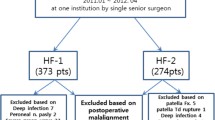Summary. Twenty-three of 327 patients with rheumatoid arthritis (38 out of 509 knees) had primary Yoshino-Shoji total knee replacements between 1984 und 1990 and were able to squat fully in the Japanese style after the procedure. Seven had died of conditions unrelated to their operations. Of the remaining 16, 5 were able to squat fully at follow-up; 2 were unable to do so, but had full passive flexion; 9 were unable to squat and did not have full flexion. The cumulative survival rates of patients able to squat were 82.2%, 65.7% and 47% at 2, 5 and 8 years after operation. At follow-up, 3 were able to walk out of doors for less than 30 min, 6 for 30 min or more and in 7 walking was unlimited. These results suggest that daily exercises are important in maintaining full flexion. The absence of complications may be due low body weight and limited activity due to the disease. Patients with rheumatoid arthritis and low body weight can be encouraged to regain full flexion after total knee replacement if they wish to do so.
Résumé. Vingt-trois parmi 327 patients (38/509 genoux) atteint de rhumatisme articulaire chronique sont devenus capables de s’asseoir à la fa*on japonaise après arthroplastie totale de genou entre 1984 et 1990. Sept patients sont morts d’affections sans rapport avec l’opération. 5 ont été capables de s’asseoir complètement au moment de la révision. 2 étaient incapables de le faire mais capables de flexion complète passive. 9 patients n’étaient capables ni de s’asseoir complètement ni de flexion complète passive. Le taux cumulatif de survie des patients capables de s’asseoir complètement était 82.2%, 65.7% et 47.0%, respectivement, 2, 5 et 8 ans après l’opération. Voici leur capacité de marche: plus de 30 minutes de marche à l’extérieur pour 3 patients, moins de 30 minutes pour 6 et “sans limite” pour 7. La moyenne du poids était de 49.7 kg (40 – 60 kg). Il n’y a eut avcune complication dans cette serie. Ces résultats suggèrent que les exercices quotidiens sont importants pour maintenir la flexion complète. L’absence de complications pourraint être attribuée au poids léger des patients et au fait que leur activité quotidienne est restreinte. Les patients légers atteint de rhumatisme articulaire chronique devraient donc être encouragés à s’exercer activement à la flexion complète après remplacement du genou par prothése totale.
Similar content being viewed by others
Author information
Authors and Affiliations
Additional information
Accepted: 12 July 1996
Rights and permissions
About this article
Cite this article
Yoshino, S., Nakamura, H., Shiga, H. et al. Recovery of full flexion after total knee replacement in rheumatoid arthritis – a follow-up study. International Orthopaedics SICOT 21, 98–100 (1997). https://doi.org/10.1007/s002640050128
Issue Date:
DOI: https://doi.org/10.1007/s002640050128




